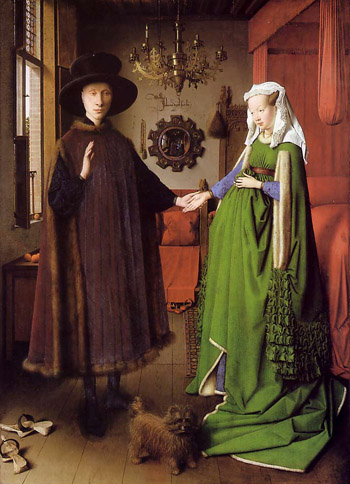
The Betrothal of the Arnolfini

|
The Betrothal of the Arnolfini
‘The Betrothal of the Arnolfini’ is perhaps the most famous and beloved painting created by Jan Van Eyck. This astonishing oil portrait on wood of Giovanni di Arrigo Arnolfini, a merchant from Lucca, and his wife Giovanna Cenami was painted in 1434. Though Van Eyck was not the first artist to use oil paints, he was indeed the first to perfect its use, as can be attested in the vibrant colors that illuminate the entirety of this scene. Van Eyck also demonstrated particular skill in creating meticulous lighting effects - exquisitely subtle in most places, but boldly predominant on the brass chandelier.
Many believe ‘The Betrothal of the Arnolfini’ to be a legal record of the couple’s wedding, but according to the National Gallery in London where it is housed, it is not. Many thought Giovanna to be with child - also a false assumption. In contemporary fashion, the lady is raising her multilayered, full-skirted dress slightly off the floor, which gives the illusion of pregnancy. The mirror that hangs on the back wall reflects two figures standing in the arch of the door frame; one may possibly be Van Eyck himself. Arnolfini raises his hand in a welcoming gesture. Above the mirror is an inscription that translates to “Jan Van Eyck was here – 1434.”
‘The Betrothal of the Arnolfini’ is rich in symbolism; the small dog at Giovanna’s feet represents faithfulness, while the carving of the patron saint of childbirth on the bed post is a symbol of coupleness. Both cleverly add to the painting’s marriage theme.
Review
The following is a review with regard to the artist: “So outstanding was his (Van Eyck’s) skill as an oil painter that the invention of the medium was at one time attributed to him, with his brother Hubert, also a painter. Van Eyck exploited the qualities of oil as never before, building up layers of transparent glazes, thus giving him a surface on which to capture objects in the minutest detail and allowing for the preservation of his colours. Nowhere is this better displayed than in the painting.” (‘The Betrothal of the Arnolfini’)
‘The Betrothal of the Arnolfini’ by Jan Van Eyck is currently located at the National Gallery, London, England.












